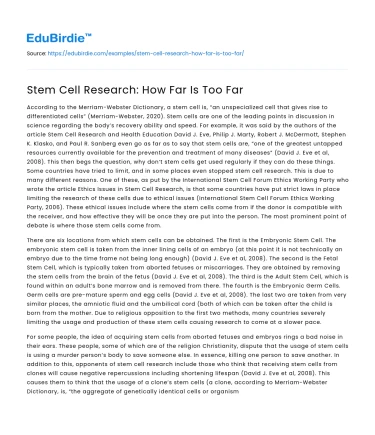According to the Merriam-Webster Dictionary, a stem cell is, “an unspecialized cell that gives rise to differentiated cells” (Merriam-Webster, 2020). Stem cells are one of the leading points in discussion in science regarding the body’s recovery ability and speed. For example, it was said by the authors of the article Stem Cell Research and Health Education David J. Eve, Philip J. Marty, Robert J. McDermott, Stephen K. Klasko, and Paul R. Sanberg even go as far as to say that stem cells are, “one of the greatest untapped resources currently available for the prevention and treatment of many diseases” (David J. Eve et al, 2008). This then begs the question, why don’t stem cells get used regularly if they can do these things. Some countries have tried to limit, and in some places even stopped stem cell research. This is due to many different reasons. One of these, as put by the International Stem Cell Forum Ethics Working Party who wrote the article Ethics Issues in Stem Cell Research, is that some countries have put strict laws in place limiting the research of these cells due to ethical issues (International Stem Cell Forum Ethics Working Party, 2006). These ethical issues include where the stem cells come from if the donor is compatible with the receiver, and how effective they will be once they are put into the person. The most prominent point of debate is where those stem cells come from.
There are six locations from which stem cells can be obtained. The first is the Embryonic Stem Cell. The embryonic stem cell is taken from the inner lining cells of an embryo (at this point it is not technically an embryo due to the time frame not being long enough) (David J. Eve et al, 2008). The second is the Fetal Stem Cell, which is typically taken from aborted fetuses or miscarriages. They are obtained by removing the stem cells from the brain of the fetus (David J. Eve et al, 2008). The third is the Adult Stem Cell, which is found within an adult’s bone marrow and is removed from there. The fourth is the Embryonic Germ Cells. Germ cells are pre-mature sperm and egg cells (David J. Eve et al, 2008). The last two are taken from very similar places, the amniotic fluid and the umbilical cord (both of which can be taken after the child is born from the mother. Due to religious opposition to the first two methods, many countries severely limiting the usage and production of these stem cells causing research to come at a slower pace.
Save your time!
We can take care of your essay
- Proper editing and formatting
- Free revision, title page, and bibliography
- Flexible prices and money-back guarantee
For some people, the idea of acquiring stem cells from aborted fetuses and embryos rings a bad noise in their ears. These people, some of which are of the religion Christianity, dispute that the usage of stem cells is using a murder person’s body to save someone else. In essence, killing one person to save another. In addition to this, opponents of stem cell research include those who think that receiving stem cells from clones will cause negative repercussions including shortening lifespan (David J. Eve et al, 2008). This causes them to think that the usage of a clone’s stem cells (a clone, according to Merriam-Webster Dictionary, is, “the aggregate of genetically identical cells or organisms asexually produced by or from a single progenitor cell or organism” (Merriam-Webster, 2020)) will cause those who acquire them to have mal interests placed into them and also further shorten the lifespan of the said person.
Stem cells were and are still a heated topic of debate for opposing views. On one end some are avid for it, using the diseases that can be cured as their rally cry and showing all of the good that can come from these stem cells. On the other side, there are the people who are showing the process and thereby the ethical issues by which these stem cells are obtained and used. Both sides of this argument have legitimate points but also have downfalls, thus the nations of today have tried to meet in the middle by allowing for research under a certain set of rules and regulations causing them to be put under supervision. As of now, this is the best that can occur for stem cell research.
References
- Eve, D. J., Marty, P. J., McDermott, R. J., Klasko, S. K., & Sanberg, P. R. (2013, January 23). Stem Cell Research and Health Education. Retrieved December 07, 2020, from https://www-tandfonline-com.chaffey.idm.oclc.org/doi/pdf/10.1080/19325037.2008.10599033
- International Stem Cell Forum Ethics Working Party. (2006). Ethics Issues in Stem Cell Research. Science, 312(5772), 366-367. Retrieved December 8, 2020, from http://www.jstor.org.chaffey.idm.oclc.org/stable/3845862
- Merriam-Webster. (n.d.). Clone. In Merriam-Webster.com dictionary. Retrieved December 10, 2020, from https://www.merriam-webster.com/dictionary/clone
- Merriam-Webster. (n.d.). Stem cell. In Merriam-Webster.com dictionary. Retrieved December 8, 2020, from https://www.merriam-webster.com/dictionary/stem%20cell
- Research Guides: A-Z Resource List: A-Z Database List. (2020). Retrieved December 08, 2020, from https://libguides.chaffey.edu/databases?controllerLanguages=GROOVY






 Stuck on your essay?
Stuck on your essay?

